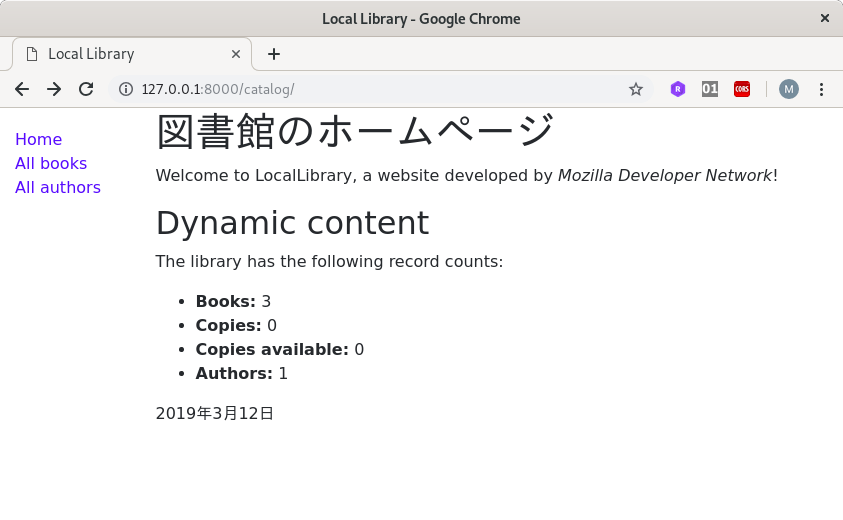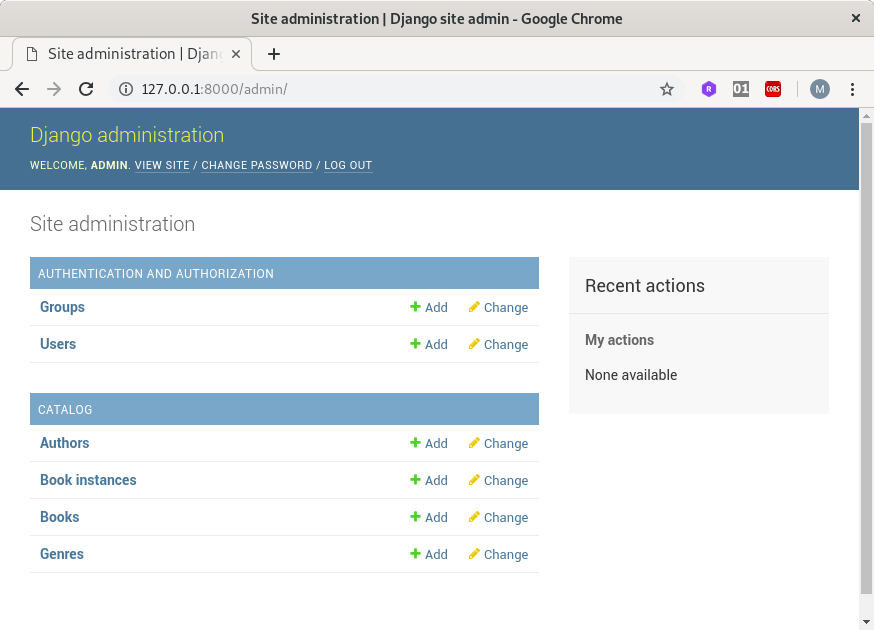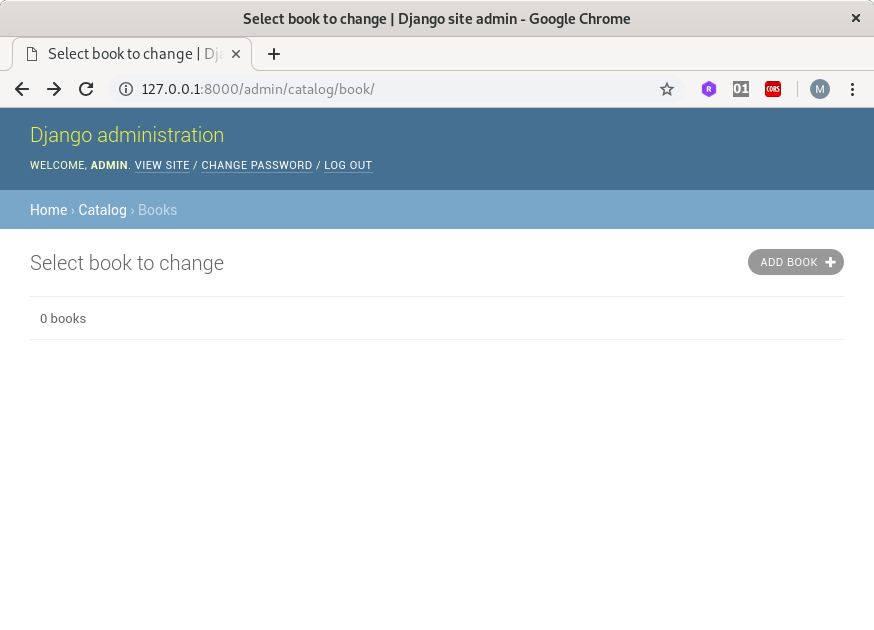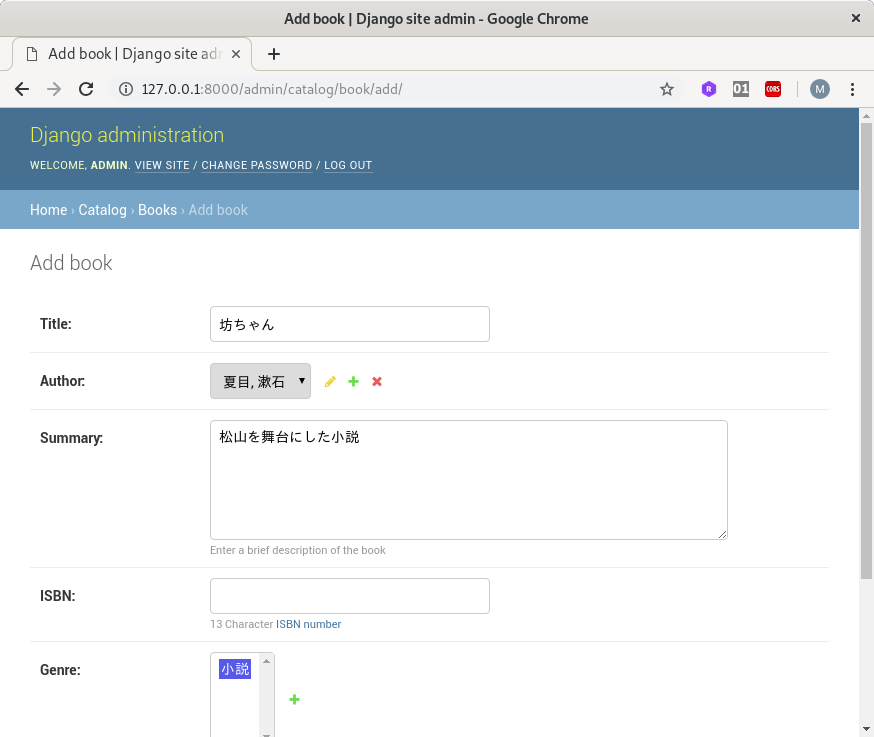次のサイトの Part5 (Creating our home page) までを行ってみました。
Django チュートリアル: 地域図書館ウェブサイト
1) プロジェクトの作成
django-admin startproject locallibrary
cd locallibrary
2) アプリの作成
python manage.py startapp catalog
3) アプリの登録
(省略)
INSTALLED_APPS = [
'django.contrib.admin',
'django.contrib.auth',
'django.contrib.contenttypes',
'django.contrib.sessions',
'django.contrib.messages',
'django.contrib.staticfiles',
'catalog.apps.CatalogConfig', # 挿入
]
(省略)
TEMPLATES = [
{
'BACKEND': 'django.template.backends.django.DjangoTemplates',
'DIRS': [
os.path.join(BASE_DIR,'templates'), # 挿入
],
'APP_DIRS': True,
'OPTIONS': {
'context_processors': [
'django.template.context_processors.debug',
'django.template.context_processors.request',
'django.contrib.auth.context_processors.auth',
'django.contrib.messages.context_processors.messages',
],
},
},
]
(省略)
4) URL の設定
from django.contrib import admin
from django.urls import path
urlpatterns = [
path('admin/', admin.site.urls),
]
# Use include() to add paths from the catalog application
from django.urls import include
from django.urls import path
urlpatterns += [
path('catalog/', include('catalog.urls')),
]
#Add URL maps to redirect the base URL to our application
from django.views.generic import RedirectView
urlpatterns += [
path('', RedirectView.as_view(url='/catalog/', permanent=True)),
]
# Use static() to add url mapping to serve static files during development (only)
from django.conf import settings
from django.conf.urls.static import static
urlpatterns += static(settings.STATIC_URL, document_root=settings.STATIC_ROOT)
catalog/urls.py は作成します。
from django.urls import path
from . import views
urlpatterns = [
path('', views.index, name='index'),
]
5) catalog/views.py の作成
from django.shortcuts import render
# Create your views here.
from catalog.models import Book, Author, BookInstance, Genre
def index(request):
"""View function for home page of site."""
# Generate counts of some of the main objects
num_books = Book.objects.all().count()
num_instances = BookInstance.objects.all().count()
# Available books (status = 'a')
num_instances_available = BookInstance.objects.filter(status__exact='a').count()
# The 'all()' is implied by default.
num_authors = Author.objects.count()
context = {
'num_books': num_books,
'num_instances': num_instances,
'num_instances_available': num_instances_available,
'num_authors': num_authors,
}
# Render the HTML template index.html with the data in the context variable
return render(request, 'catalog/index.html', context=context)
6) catalog/models.py の作成
from django.db import models
# Create your models here.
class Genre(models.Model):
"""Model representing a book genre."""
name = models.CharField(max_length=200, help_text='Enter a book genre (e.g. Science Fiction)')
def __str__(self):
"""String for representing the Model object."""
return self.name
from django.urls import reverse # Used to generate URLs by reversing the URL patterns
class Book(models.Model):
"""Model representing a book (but not a specific copy of a book)."""
title = models.CharField(max_length=200)
# Foreign Key used because book can only have one author, but authors can have multiple books
# Author as a string rather than object because it hasn't been declared yet in the file
author = models.ForeignKey('Author', on_delete=models.SET_NULL, null=True)
summary = models.TextField(max_length=1000, help_text='Enter a brief description of the book')
isbn = models.CharField('ISBN', max_length=13, help_text='13 Character <a href="https://www.isbn-international.org/content/what-isbn">ISBN number</a>')
# ManyToManyField used because genre can contain many books. Books can cover many genres.
# Genre class has already been defined so we can specify the object above.
genre = models.ManyToManyField(Genre, help_text='Select a genre for this book')
def __str__(self):
"""String for representing the Model object."""
return self.title
def get_absolute_url(self):
"""Returns the url to access a detail record for this book."""
return reverse('book-detail', args=[str(self.id)])
import uuid # Required for unique book instances
class BookInstance(models.Model):
"""Model representing a specific copy of a book (i.e. that can be borrowed from the library)."""
id = models.UUIDField(primary_key=True, default=uuid.uuid4, help_text='Unique ID for this particular book across whole library')
book = models.ForeignKey('Book', on_delete=models.SET_NULL, null=True)
imprint = models.CharField(max_length=200)
due_back = models.DateField(null=True, blank=True)
LOAN_STATUS = (
('m', 'Maintenance'),
('o', 'On loan'),
('a', 'Available'),
('r', 'Reserved'),
)
status = models.CharField(
max_length=1,
choices=LOAN_STATUS,
blank=True,
default='m',
help_text='Book availability',
)
class Meta:
ordering = ['due_back']
def __str__(self):
"""String for representing the Model object."""
return f'{self.id} ({self.book.title})'
class Author(models.Model):
"""Model representing an author."""
first_name = models.CharField(max_length=100)
last_name = models.CharField(max_length=100)
date_of_birth = models.DateField(null=True, blank=True)
date_of_death = models.DateField('Died', null=True, blank=True)
class Meta:
ordering = ['last_name', 'first_name']
def get_absolute_url(self):
"""Returns the url to access a particular author instance."""
return reverse('author-detail', args=[str(self.id)])
def __str__(self):
"""String for representing the Model object."""
return f'{self.last_name}, {self.first_name}'
7) マイグレーション
python manage.py makemigrations
python manage.py migrate
8) テンプレートの作成
mkdir catalog/templates
mkdir catalog/templates/catalog
mkdir catalog/static
mkdir catalog/static/css
<!DOCTYPE html>
<html lang="ja">
<head>
{% block title %}<title>Local Library</title>{% endblock %}
<meta charset="utf-8">
<meta name="viewport" content="width=device-width, initial-scale=1">
<link rel="stylesheet" href="https://stackpath.bootstrapcdn.com/bootstrap/4.1.3/css/bootstrap.min.css" integrity="sha384-MCw98/SFnGE8fJT3GXwEOngsV7Zt27NXFoaoApmYm81iuXoPkFOJwJ8ERdknLPMO" crossorigin="anonymous">
<!-- Add additional CSS in static file -->
{% load static %}
<link rel="stylesheet" href="{% static 'css/styles.css' %}">
</head>
<body>
<div class="container-fluid">
<div class="row">
<div class="col-sm-2">
{% block sidebar %}
<ul class="sidebar-nav">
<li><a href="{% url 'index' %}">Home</a></li>
<li><a href="">All books</a></li>
<li><a href="">All authors</a></li>
</ul>
{% endblock %}
</div>
<div class="col-sm-10 ">{% block content %}{% endblock %}
2019年3月12日<p />
</div>
</div>
</div>
</body>
</html>
{% extends "catalog/base_generic.html" %}
{% block content %}
<h1>図書館のホームページ</h1>
<p>Welcome to LocalLibrary, a website developed by <em>Mozilla Developer Network</em>!</p>
<h2>Dynamic content</h2>
<p>The library has the following record counts:</p>
<ul>
<li><strong>Books:</strong> {{ num_books }}</li>
<li><strong>Copies:</strong> {{ num_instances }}</li>
<li><strong>Copies available:</strong> {{ num_instances_available }}</li>
<li><strong>Authors:</strong> {{ num_authors }}</li>
</ul>
{% endblock %}
.sidebar-nav {
margin-top: 20px;
padding: 0;
list-style: none;
}
9) 開発サーバーの起動
python manage.py runserver
ブラウザーで http://127.0.0.1:8000/ にアクセス
まだデータが入っていないので、0 が表示されます。
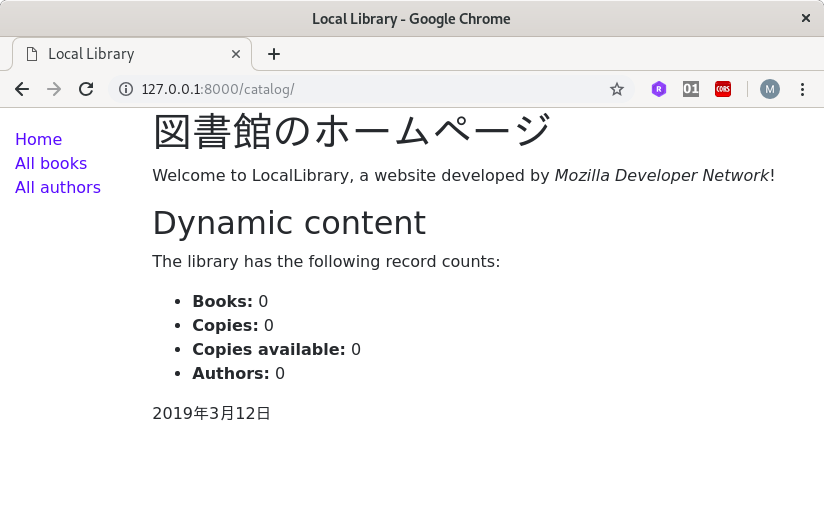
10) スーパーユーザーの作成
データを入れる為にスーパーユーザーを作成します。
python manage.py createsuperuser
実行時の様子
$ python manage.py createsuperuser
Username (leave blank to use 'uchida'): admin
Email address: test@test.com
Password:
Password (again):
This password is too short. It must contain at least 8 characters.
This password is too common.
Bypass password validation and create user anyway? [y/N]: y
Superuser created successfully.
11) catalog/admin.py の編集
データベースを編集できるように設定します。
from django.contrib import admin
# Register your models here.
from catalog.models import Author, Genre, Book, BookInstance
admin.site.register(Book)
admin.site.register(Author)
admin.site.register(Genre)
admin.site.register(BookInstance)
12) 開発サーバーを起動して、http://127.0.0.1:8000/admin にアクセス
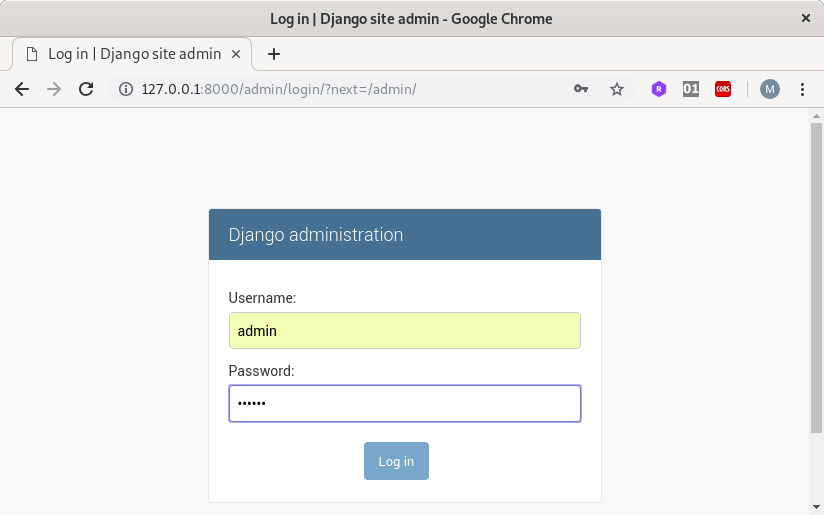
14) admin からログアウトしてカタログを確認
本を3冊、作者を一人登録して、
http://127.0.0.1:8000
にアクセスすると、
次のように表示されます。
Books: 3
Copies: 0
Copies available: 0
Authors: 1
続きは次の通り
Django チュートリアル: 地域図書館ウェブサイト (その2)
Django チュートリアル: 地域図書館ウェブサイト (その3)
Django チュートリアル: 地域図書館ウェブサイト (その4)
Django チュートリアル: 地域図書館ウェブサイト (その5)
Django チュートリアル: 地域図書館ウェブサイト (その6)
Django チュートリアル: 地域図書館ウェブサイト (その7)
